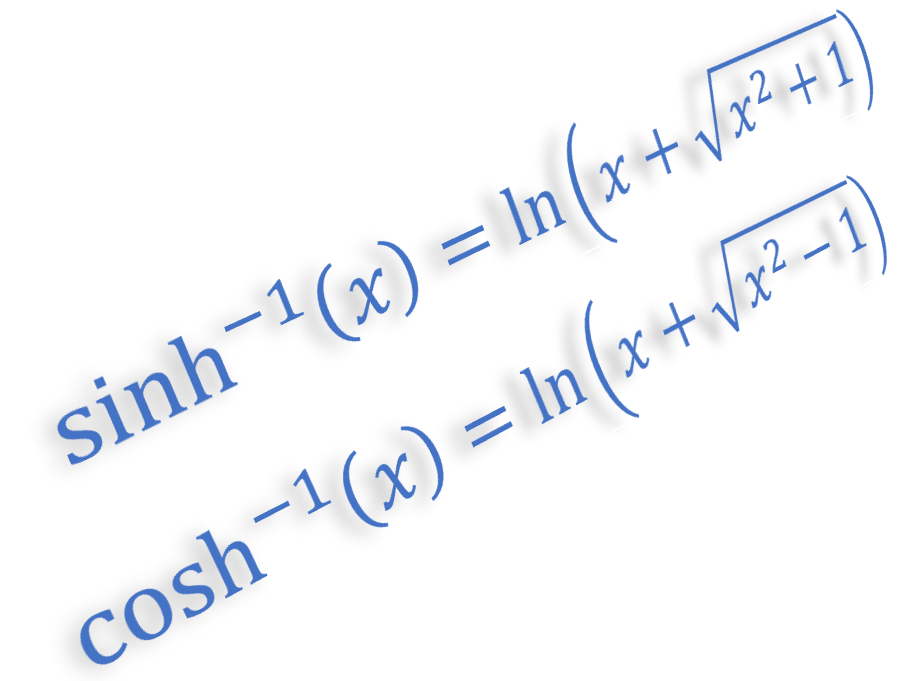HF3 Inverse hyperbolic functions

The hyperbolic functions are widely used in engineering, science and mathematics. Providing a function is one to one, it is possible to find an inverse function. This module discusses inverse hyperbolic functions. These are used in advanced calculus for integration and in the solution of differential equations.
Definitions
The basic hyperbolic functions are sinh and cosh and are defined as follows.
The hyperbolic sine function is
\[\begin{align*} \sinh\left(x\right) & =\frac{e^{x}-e^{-x}}{2}. \end{align*}\] It is pronounced as “shine \(x\)”.
The hyperbolic cosine function is defined as \[\begin{align*} \cosh\left(x\right) & =\frac{e^{x}+e^{-x}}{2}. \end{align*}\] It is pronounced as “cosh \(x\)”.
In addition to these we also define \[\begin{align*} \tanh\left(x\right) & =\frac{\sinh\left(x\right)}{\cosh\left(x\right)}\\ & =\frac{e^{x}-e^{-x}}{e^{x}+e^{-x}}. \end{align*}\] It is pronounced as “than \(x\)” where the “than” is pronounced as in “thank”.
Just as for the circular functions, there are reciprocal hyperbolic functions. They are:
\[\begin{align*} \text{$\text{coshec$\left(x\right)$ }$ } & =\frac{1}{\sinh\left(x\right)}\\ \text{sech$\left(x\right)$ } & =\frac{1}{\cosh\left(x\right)}\\ \coth\left(x\right) & =\frac{1}{\tanh\left(x\right)}. \end{align*}\]
Inverse Hyperbolic Functions
Inverse hyperbolic functions may also be defined.
The inverse sinh function is \(\sinh^{-1}\) and is sometimes denoted as \(\text{asinh or $\text{arcsinh.}$ }\)The latter is pronounced “arc shine”.
The inverse cosh function is \(\cosh^{-1}\) and is sometimes denoted by \(\text{acosh}\left(x\right)\) or \(\text{arccosh$\left(x\right)$ .}\) The latter is pronounced “arc cosh”. Note that \(\cosh\left(x\right)\) is not one to one. Restricting its domain to \([0,\infty)\), it is one to one and the inverse function is defined for this restricted function.
Finally, the inverse \(\tanh\) function is \(\tanh^{-1}\) or \(\text{atanh}\) or \(\text{arctanh.}\) The latter is pronounced “arc than”.
The inverse hyperbolic functions may be written in terms of the natural log function as \[\begin{align*} \sinh^{-1}\left(x\right) & =\ln\left(x+\sqrt{x^{2}+1}\right)\\ \cosh^{-1}\left(x\right) & =\ln\left(x+\sqrt{x^{2}-1}\right),\ x\geq1\\ \tanh^{-1}\left(x\right) & =\frac{1}{2}\ln\left(\frac{1+x}{1-x}\right),\ \left|x\right|<1\\ \text{csch$^{-1}\left(x\right)$ } & =\ln\left(\sqrt{\frac{1}{x^{2}}+1}+\frac{1}{x}\right),\ -\infty<x<\infty,\ x\neq0\\ \text{sech$^{-1}\left(x\right)$ } & =\ln\left(\sqrt{\frac{1}{x^{2}}-1}+\frac{1}{x}\right),\ 0<x\leq1\\ \text{coth$^{-1}$ }\left(x\right) & =\frac{1}{2}\ln\left(\frac{x+1}{x-1}\right),\ -\infty<x<-1\text{ or $1<x<\infty.$ } \end{align*}\]
Derivative of Inverse Hyperbolic Functions
The derivatives of the inverse hyperbolic functions are: \[\begin{align*} \frac{d}{dx}\text{sinh$^{-1}\left(x\right)$ } & =\frac{1}{\sqrt{x^{2}+1}},\text{ for all real }x\\ \frac{d}{dx}\text{cosh$^{-1}$ $\left(x\right)$ } & =\frac{1}{\sqrt{x^{2}-1}},\text{for all real }x>1\\ \frac{d}{dx}\tanh^{-1}\left(x\right) & =\frac{1}{1-x^{2}},\text{ for all real }|x|<1\\ \frac{d}{dx}\text{csch$^{-1}\left(x\right)$ } & =\frac{-1}{|x|\sqrt{1+x^{2}}},\text{ for all real }x,x\neq0\\ \frac{d}{dx}\text{sech$^{-1}\left(x\right)$ } & =\frac{-1}{x\sqrt{1-x^{2}}},\text{ for all real }x\in(0,1)\\ \frac{d}{dx}\text{coth$^{-1}$ }\left(x\right) & =\frac{1}{1-x^{2}},\text{ for all real }|x|>1 \end{align*}\]
Example 1
What is the derivative of \(\sinh^{-1}\left(4x\right)\)?
Solution:
Since \(\frac{d}{dx}\text{sinh$^{-1}\left(x\right)$ }=\frac{1}{\sqrt{x^{2}+1}}\), we use the chain rule with \(u=4x.\) So \[\begin{align*} \frac{du}{dx} & =4 \end{align*}\] and \[\begin{align*} \frac{d}{dx} & \sinh^{-1}\left(4x\right)=\\ \frac{d}{dx}\sinh^{-1}\left(4x\right) & =\frac{d}{du}\sinh^{-1}\left(u\right)\frac{du}{dx}\\ & =\frac{1}{\sqrt{u^{2}+1}}\cdot4\\ & =\frac{4}{\sqrt{\left(4x\right)^{2}+1}}\\ & =\frac{4}{\sqrt{16x^{2}+1}}. \end{align*}\]
Alternative solution:
Using the definition of sinh\(^{-1}\left(x\right)\) in terms of the natural log function, \[\begin{align*} \sinh^{-1}\left(4x\right) & =\ln\left(4x+\sqrt{\left(4x\right)^{2}+1}\right)\\ & =\ln\left(4x+\sqrt{16x^{2}+1}\right). \end{align*}\] Setting \(u=4x+\sqrt{16x^{2}+1}\), \[\begin{align*} \frac{du}{dx} & =4+\frac{1}{2}\left(16x^{2}+1\right)^{-\frac{1}{2}}\left(32x\right)\\ & =4+16x\left(16x^{2}+1\right)^{-\frac{1}{2}}. \end{align*}\] Using the chain rule, \[\begin{align*} \frac{d}{dx}\left(\sinh^{-1}\left(4x\right)\right) & =\frac{d}{dx}\left(\ln\left(4x+\sqrt{16x^{2}+1}\right)\right)\\ & =\frac{d}{du}\left(\ln\left(u\right)\right)\frac{du}{dx}\\ & =\frac{1}{u}\left(4+16x\left(16x^{2}+1\right)^{-\frac{1}{2}}\right)\\ & =\frac{4+16x\left(16x^{2}+1\right)^{-\frac{1}{2}}}{4x+\sqrt{16x^{2}+1}}. \end{align*}\] Now, rationalise the denominator by multiplying the top and bottom by \(4x-\sqrt{16x^{2}+1}\), \[\begin{align*} \frac{d}{dx}\left(\sinh^{-1}\left(4x\right)\right) & =\frac{4+16x\left(16x^{2}+1\right)^{-\frac{1}{2}}}{4x+\sqrt{16x^{2}+1}}\times\frac{4x-\sqrt{16x^{2}+1}}{4x-\sqrt{16x^{2}+1}}\\ & =\frac{16x-4\sqrt{16x^{2}+1}+64x^{2}\left(16x^{2}+1\right)^{-\frac{1}{2}}-16x}{16x^{2}-16x^{2}-1}\\ & =4\sqrt{16x^{2}+1}-64x^{2}\left(16x^{2}+1\right)^{-\frac{1}{2}}\\ & =4\left(\sqrt{16x^{2}+1}-\frac{16x^{2}}{\sqrt{16x^{2}+1}}\right)\\ & =4\left(\frac{16x^{2}+1}{\sqrt{16x^{2}+1}}-\frac{16x^{2}}{\sqrt{16x^{2}+1}}\right)\\ & =\frac{4}{\sqrt{16x^{2}+1}}. \end{align*}\]
Exercises
Find the derivative, with respect to \(x,\) of
\(\quad\)a) \(y=6\cosh^{-1}\left(x/3\right)\)
\(\quad\)b) \(y=\frac{1}{2}\sinh^{-1}\left(2x+1\right)\).Express \(\sinh^{-1}\left(-\frac{5}{12}\right)\) in terms of the natural log function.
Answers
- \(\frac{6}{\sqrt{x^{2}-9}}\qquad\text{b) $\frac{1}{\sqrt{\left(2x+1\right)^{2}+1}}$ }\)
- \(\ln\left(2/3\right)\)
Download this page: HF3 Inverse Hyperbolic Functions (PDF 252KB)
